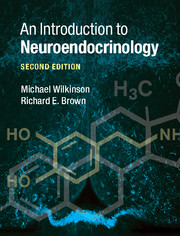Book contents
- Frontmatter
- Dedication
- Contents
- Preface to the second edition
- Acknowledgements
- List of abbreviations
- 1 Classification of chemical messengers
- 2 The endocrine glands and their hormones
- 3 The pituitary gland and its hormones
- 4 The hypothalamic hormones
- 5 Neurotransmitters
- 6 Neurotransmitter and neuropeptide control of hypothalamic, pituitary and other hormones
- 7 Regulation of hormone synthesis, storage, release, transport and deactivation
- 8 Regulation of hormone levels in the bloodstream
- 9 Steroid and thyroid hormone receptors
- 10 Receptors for peptide hormones, neuropeptides and neurotransmitters
- 11 Neuropeptides I: classification, synthesis and co-localization with classical neurotransmitters
- 12 Neuropeptides II: function
- 13 Cytokines and the interaction between the neuroendocrine and immune systems
- 14 Methods for the study of behavioral neuroendocrinology
- 15 An overview of behavioral neuroendocrinology: present, past and future
- Index
- References
4 - The hypothalamic hormones
Published online by Cambridge University Press: 05 June 2015
- Frontmatter
- Dedication
- Contents
- Preface to the second edition
- Acknowledgements
- List of abbreviations
- 1 Classification of chemical messengers
- 2 The endocrine glands and their hormones
- 3 The pituitary gland and its hormones
- 4 The hypothalamic hormones
- 5 Neurotransmitters
- 6 Neurotransmitter and neuropeptide control of hypothalamic, pituitary and other hormones
- 7 Regulation of hormone synthesis, storage, release, transport and deactivation
- 8 Regulation of hormone levels in the bloodstream
- 9 Steroid and thyroid hormone receptors
- 10 Receptors for peptide hormones, neuropeptides and neurotransmitters
- 11 Neuropeptides I: classification, synthesis and co-localization with classical neurotransmitters
- 12 Neuropeptides II: function
- 13 Cytokines and the interaction between the neuroendocrine and immune systems
- 14 Methods for the study of behavioral neuroendocrinology
- 15 An overview of behavioral neuroendocrinology: present, past and future
- Index
- References
Summary
Chapters 2 and 3 surveyed the hormones of the endocrine and pituitary glands. This chapter outlines the functions of the hypothalamus, and the hypothalamic neurosecretory cells and examines the role of the hypothalamus in controlling the release of pituitary hormones.
Functions of the hypothalamus
The hypothalamus is located at the base of the forebrain, below the thalamus (see Figure 3.1), and is divided into two halves, along the midline, by the third ventricle, which is filled with cerebrospinal fluid (CSF). As shown in a coronal (frontal) section in Figure 4.1, the hypothalamus contains many groups, or nuclei, of nerve cell bodies. The medial basal hypothalamus, consisting of the VMH, ARC and median eminence, is often referred to as the “endocrine hypothalamus” because of its neuroendocrine functions. For students interested in further details, a description of the anatomy of the hypothalamus can be found elsewhere (Norris 2007; Page 2006; Squire et al. 2008).
It is beyond the scope of this book to consider in detail the many and complex roles of the hypothalamus in maintaining normal bodily functions. But bear in mind that this brain center exerts an amazing diversity of critical controls, including growth, reproduction, temperature control, metabolism and body weight, emotional behavior (anger, fear, euphoria), motivational arousal (hunger, thirst, aggression and sexual arousal), circadian rhythms, stress and fluid balance. It contains multiple internal connections between neurons, but in addition receives neural information from other brain regions such as amygdala, hippocampus and spinal cord. The hypothalamus is well supplied with blood vessels and is therefore the recipient of essential information from the bloodstream, such as temperature and hormone levels. Thus, we can appreciate the importance of the hypothalamus in integrating and responding to all of this information by modifying its output of neural and neuroendocrine signaling.
These functions of the hypothalamus can be “localized” to particular nuclei, although any boundaries, such as those outlined in Figure 4.1, should be regarded only as approximate guides.
- Type
- Chapter
- Information
- An Introduction to Neuroendocrinology , pp. 57 - 77Publisher: Cambridge University PressPrint publication year: 2015



